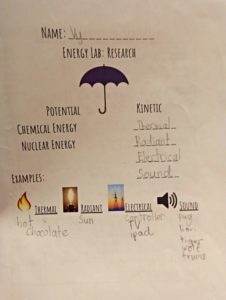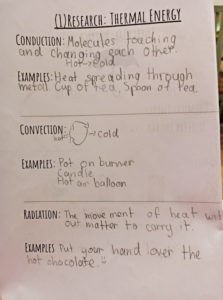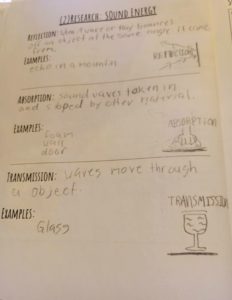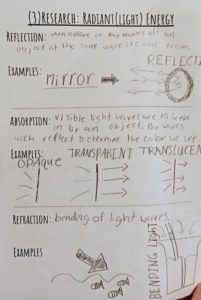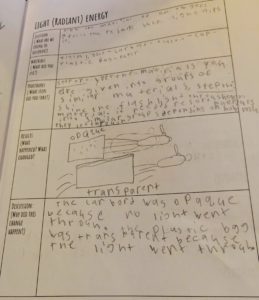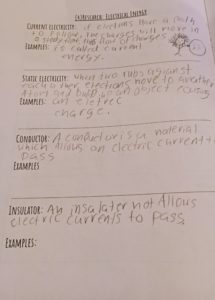Unit Wide Learning Goals:
- Students will be able to define lesson specific vocabulary.
- Students will be able to provide real world examples of each lesson specific vocabulary.
- Students will be able to work with their lab partner to complete an experiment and their lab report.
- Students will be able to use lesson specific knowledge to explain results of an experiment.
LAP 1: What is energy?
- SWBAT define energy.
- SWBAT give examples of and define in their own words kinetic and potential energy.
- SWBAT give example of and define in their own words radiant energy, electrical energy, thermal energy, and sound energy.
Activity:
Students learned the basics of energy through Energy Makes Things Happen by Kimberly Brubaker Bradley, a Bill Nye video, and an additional educational video. Following this the class took notes on the vocabulary and record real world examples in their lab reports. Following this the students showed their learning and decision making through a four corners activity.
Student Work Samples:
LAP 2: What is thermal energy?
- SWBAT explain conduction, convection, and radiation.
- SWBAT give an example of each type of heat transfer.
- SWBAT will work with their lab partner to complete an experiment and their lab report.
Activity: Day one:
The students researched thermal energy using an educational video and by completing a jigsaw reading from their science textbooks. Following this the students completed their research page in their lab report.
Activity: Day two:
Students will be placed into lab groups. After this they will complete one of the following heat experiments.
- Color swirl (see a video of this here under the column name Thermal Energy: Videos or Materials)
- Ice cube races
- Magic Balloon
After the students completed their experiment and filling out their lab report they reconvened on the rug to complete a “science conference” meaning the students shared what their experiment was, what the results were, and explain why they think these results occurred.
Student Work Sample:

This student was able to fill in their lab report appropriately and use their previous knowledge to explain their results.
LAP 3: What is sound energy?
- SWBAT define and give examples of reflection, refraction, absorption, opaque, translucent, and transparent.
- SWBAT show what they have learned over the past three lessons through a quiz.
- SWBAT explain using knowledge about sound, why the results which occurred in their experiment happened.
Activities: Day one:
During the first day of this lesson students watched a series of videos showing an example of the different reactions of sound waves in specific situations. After recording this information in their lab reports the students were given a short quiz as a form of check in about the content throughout the unit thus far.
Student Work Sample:
Activities: Day two:
Students will be placed into lab groups. After this they will complete one of the following sound experiments.
- Rubber Band, Band (see a video of this here under the column name Thermal Energy: Videos or Materials)
- Dancing Sprinkles
- Spy Code
After the students complete their experiment and filling out their lab report they will reconvene on the rug to complete a “science conference” meaning the students will share what their experiment was, what the results were, and explain why they think these results occurred.
Student Work Sample:
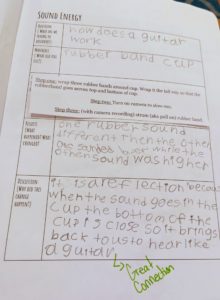
This student completed more work during this lesson than was average for him, with the support of his lab partners. He also made a great connection!
What is radiant energy?
- SWBAT provide examples and self-created definitions of reflection, absorption, transmission.
- SWBAT take initial research notes and detailed/ rationalized experiment notes.
- SWBAT use their knowledge about light waves and light energy to participate in a kinesthetic true and false game.
Activities: Day one:
Students will access information through video content and then apply such knowledge to participate in a true and false review. During this review each side of the room was labeled true or false. A statement will be posted on the board and students will have to choose what side of the room they would like to join.
Student Work Sample:
Activities: Day two:
Students were placed into lab groups. After this they completed one of the following light experiments.
After the students completed their experiment and filling out their lab report they will reconvene on the rug to complete a “science conference” meaning the students will share what their experiment was, what the results were, and explain why they think these results occurred.
Student Work Sample:
What is electrical energy?
- SWBAT work as lab partners to break the code and complete and experiment.
- SWBAT define the present vocabulary and give an example.
- SWBAT explain each answer they provide throughout the two days of this lesson.
Activities: Day one:
On the first day of this lesson students obtained new knowledge about electrical energy through their textbook. The students were given 11 statements with specific letters on the back they will then have to decide if the statements are true or false. Once the students have used their textbooks and their partners as a resource to sort the true and false statements into a specific order to find the secret code. After this activity they will be asked to complete their lab reports.
Student Work Sample:
Activities: Day two:
Students will be placed into lab groups. After this, through experimentation students will work to complete a closed circuit.
After the students completed their experiment and filling out their lab report they will reconvene on the rug to complete a “science conference” meaning the students will share what their experiment was, what the results were, and explain why they think these results occurred.
To see an example of this exploration click here. To see and example of a science conference click here.
Student Work Sample:
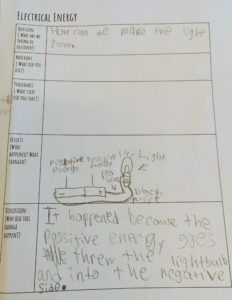
The students instructed to leave specific sections of their lab report blank. I was impressed by the students diagram and use of vocabulary in the explanation.
How do we see energy used in our daily lives?
- SWBAT show good sportsmanship while participating in a review game.
- SWBAT utilize their knowledge of the four types of energy to participate in review and a test.
- SWBAT explain why they chose the answer they did.
Activities: Day one:
The first day of this lesson, the students will participate in a review game of Kahoot. Following each question I wall ask a different student for their reasoning behind their answer.
Activities: Day two:
On the second day of this lesson the students will complete a multiple choice and short answer Google Forms test.
To get a look at this Kahoot game and the Google form test click here under the column titled “Energy Transfer: Videos or Materials”.

